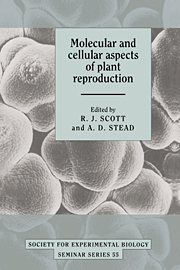Book contents
- Frontmatter
- Contents
- List of Contributors
- Introduction: ‘Where do we go from here?’
- Molecular control of floral organogenesis and plant reproduction in Petunia hybrida
- Control of floral morphogenesis in cauliflower (Brassica oleracea L. var. botrytis): the role of homeotic genes
- Isolation and properties of mutants of Arabidopsis thaliana with reduced sensitivity to short days
- Asexual mutants in Melandrium album (Silene alba): tools in cDNA cloning and analysis of an X/Y chromosome system in plants
- Pollen exine – the sporopollenin enigma and the physics of pattern
- The diversity and regulation of gene expression in the pathway of male gametophyte development
- Characterisation of Arabidopsis thaliana anther-specific gene which shares sequence similarity with β-1,3-glucanases
- Ovule cDNA clones of Petunia hybrida encoding proteins homologous to MAP and shaggy/zeste-white 3 protein kinases
- Towards the elucidation of the mechanisms of pollen tube inhibition during the self-incompatibility response in Papaver rhoeas
- Intracellular movement and pollen physiology: progress and prospects
- Organisation and functions of cell surface molecules on gametes of the brown algae Fucus
- Strategies of flower senescence – a review
- The physiology of petal senescence which is not initiated by ethylene
- Molecular biology of flower senescence in carnation
- Ethylene sensitivity and flower senescence
- Ethylene biosynthetic genes and inter-organ signalling during flower senescence
- Index
Pollen exine – the sporopollenin enigma and the physics of pattern
Published online by Cambridge University Press: 04 August 2010
- Frontmatter
- Contents
- List of Contributors
- Introduction: ‘Where do we go from here?’
- Molecular control of floral organogenesis and plant reproduction in Petunia hybrida
- Control of floral morphogenesis in cauliflower (Brassica oleracea L. var. botrytis): the role of homeotic genes
- Isolation and properties of mutants of Arabidopsis thaliana with reduced sensitivity to short days
- Asexual mutants in Melandrium album (Silene alba): tools in cDNA cloning and analysis of an X/Y chromosome system in plants
- Pollen exine – the sporopollenin enigma and the physics of pattern
- The diversity and regulation of gene expression in the pathway of male gametophyte development
- Characterisation of Arabidopsis thaliana anther-specific gene which shares sequence similarity with β-1,3-glucanases
- Ovule cDNA clones of Petunia hybrida encoding proteins homologous to MAP and shaggy/zeste-white 3 protein kinases
- Towards the elucidation of the mechanisms of pollen tube inhibition during the self-incompatibility response in Papaver rhoeas
- Intracellular movement and pollen physiology: progress and prospects
- Organisation and functions of cell surface molecules on gametes of the brown algae Fucus
- Strategies of flower senescence – a review
- The physiology of petal senescence which is not initiated by ethylene
- Molecular biology of flower senescence in carnation
- Ethylene sensitivity and flower senescence
- Ethylene biosynthetic genes and inter-organ signalling during flower senescence
- Index
Summary
Angiosperm pollen represents the pinnacle of an evolutionary progression towards gametophyte miniaturisation that probably began with the development of a toughened wall surrounding the zygote of charphycean algae, the progenitor of the land plants, some 400 million years ago (Delwiche, Graham & Thomson, 1989). The combination of acute vulnerability and central importance in the life-cycle of sexually reproducing plants inherent in the usually brief life-cycle of the male spore has driven the assembly of various adaptive features that endow its protective capsule with remarkable properties. Foremost among these is the unparalleled combination of physical strength, chemical inertness and resistance to biological attack of the outer wall, or exine, due principally to its major structural component, sporopollenin. The evolutionary history of sporopollenin, and that of the spores of land plants, is indivisible (see Chaloner, 1976). Fossil green algae dating back to the Devonian period have been shown to contain sporopollenin (Wall, 1962) and there are reports that sporopollenin also occurs in fungi (see Shaw, 1971) indicating an origin predating the appearance of plants. In an article that fuelled the debate about the existence of extra-terrestrial life, Brooks and Shaw (1969) also reported the presence of sporopollenin in meteorites and suggested that the origin of sporopollenin could even predate life on earth.
However, the exine is often much more than a protective shield. In angiosperms, for example, the pollen wall of many species has become modified to carry specific self-incompatibility proteins that promote outbreeding.
- Type
- Chapter
- Information
- Molecular and Cellular Aspects of Plant Reproduction , pp. 49 - 82Publisher: Cambridge University PressPrint publication year: 1994
- 91
- Cited by

